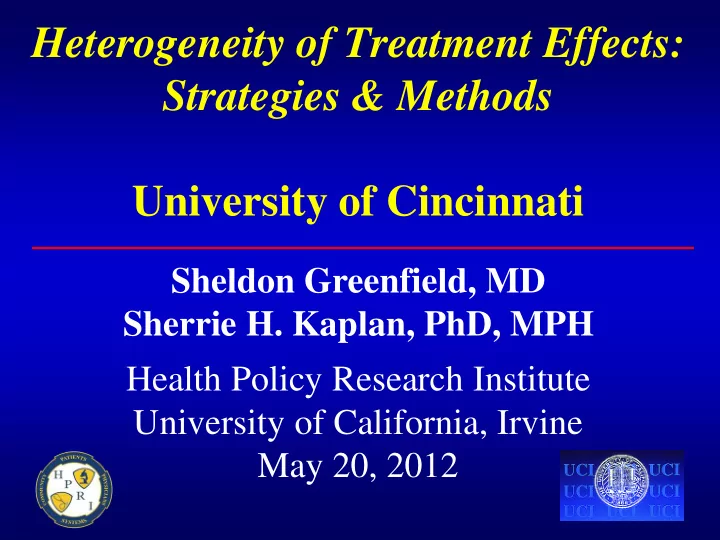

Heterogeneity of Treatment Effects: Strategies & Methods University of Cincinnati Sheldon Greenfield, MD Sherrie H. Kaplan, PhD, MPH Health Policy Research Institute University of California, Irvine May 20, 2012
Definition of Heterogeneity of Treatment Effects • Variation in outcomes within clinically defined populations • Disjunction between the overall ( summary, average ) effects of a treatment vs. effects in individuals or subsets
Urgency • Evolving disease epidemiology: the failure of chronic disease nosology • Quality, CPGs, coverage
3 Overarching Causes • Genetic/biologic • Clinical stage/severity/outcome risk • Beyond the disease: comorbidity, passivity, burden, “resiliency”
Understudied Sources of Individual Patient Variation Heterogeneity of treatment effects can be due to variables that include: • Biologic causes (e.g. biomarkers, stages detected by imaging, differences in metabolism, etc.). • Disease severity (i.e. those sicker at baseline respond more favorably)
Understudied Sources of Individual Patient Variation (cont’) • Comorbidity, as a determinant of response due to: - Competing risk for mortality or other outcomes - Disease-disease interactions - Drug-drug interactions - Burden of polypharmacy
Understudied Sources of Individual Patient Variation (cont’) • Functional status, quality of life, resilience • Social support • Depression or other mental health problems • Medical context, e.g. - Willingness and ability to work with providers to optimize/tailor treatments
Understudied Sources of Individual Patient Variation (cont’) • Personal, cultural • Adherence to treatment
Recent Trials With Misleading Results • Prostate cancer • Carotid endarterectomy • Healthy • ASA for peripheral vascular disease
Recent Trials With Misleading Results • ACCORD • ADVANCE • DVT • CATIE
The Diabetes Story
Reduction in Risk for Cardiovascular Events Associated With HbA1c Level 6.5% or Less or 7.0% or Less, by TIBI Subgroup
Solutions • Don’t do studies with mixed populations: use prior data • Stratified studies/ matching
Multivariable Models • CHADS • GRACE • Atrial fibrillation • Endarterectomy • TIBI
Hypothetical Example
The Total Illness Burden Index: Scoring and Validation
Dimensions of the TIBI Eye and Vision Conditions Congestive Hearing Heart Problems Failure Gastro- Foot Disease Intestinal Total Disease Illness Burden (TIBI) Pulmonary Atherosclerotic Disease Heart Disease Stroke and Arthritis Neurological Disease
Scoring Shortness of Breath 1. During the past 4 weeks, how often have you felt short of breath… (circle one number on each line) ALL of MOST SOME of A NONE the of the the Time LITTLE of the Time Time of the Time Time a. When lying down flat?………………………………………….. 1 2 3 4 5 b. When sitting, resting?…………………………………………... 1 2 3 4 5 c. When walking less than one block?…………………………... 1 2 3 4 5 d. When climbing one flight of stairs?…………….……………... 1 2 3 4 5 e. When climbing several flights of stairs?……….…………….. 1 2 3 4 5 • If any in orange zone are circled, add 5 • If any in yellow zone are circled, add 3 • If any in green zone are circled, add 1 • Note: Risk factors from other questions (swelling in ankles, Hx of heart disease, etc) may result in addition of 1 more.
Scoring COPD 1. Do you have a regular or daily cough? (check one) NO YES 1 8a . When you cough, how much phlegm or sputum do you cough up? 2 (circle one) None………………………………………………………………. 1 Less than a teaspoonful a day…………………………………. 2 About a tablespoonful a day…………………………………… 3 Several tablespoonfuls a day………………………………….. 4 About a cup or more a day……………………………………... 5 If one tablespoon or more, add 2 to total. If less than a teaspoon add 1 to total. If none, add 0 to total.
Scoring COPD Have you ever been told by a physician that you have any of the following problems with your breathing? NO YES 1 2 Emphysema………………………………………………………….. 1 2 Chronic bronchitis………………………………….….…………….. Asthma………………………………………………………………… 1 2 If “ yes ” to any of these, add 1 to total.
Steps in Constructing Subdimensions • Transformed variables to uniform metric • Tested reliability of clinically defined scale (Cronbach ’ s alpha > .80) • Created composite of each subdimension using simple algebraic sum, mean • Items in each subdimension varied • Validated each subdimension as scale using SF-36, etc.
Summing the Scales • A total score for TIBI is computed by transforming and summing all of the scales. • Validation of composite score robust across scoring methods.
Table 4. Domain scores for each disease cohort: outcome category discrimination by ENSEMBLE MDS domains
Table 4. Domain scores for each disease cohort: outcome category discrimination by ENSEMBLE MDS domains
Conclusions • With CER, heterogeneity cannot be ignored • Need to collect data on causes • Need solutions such as stratification
Recommend
More recommend